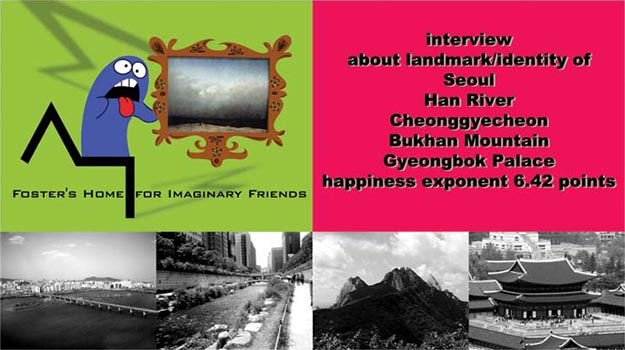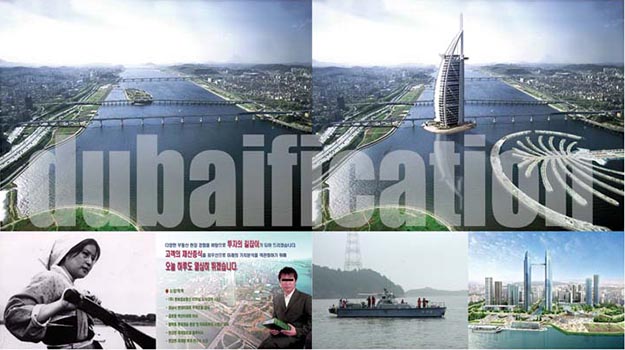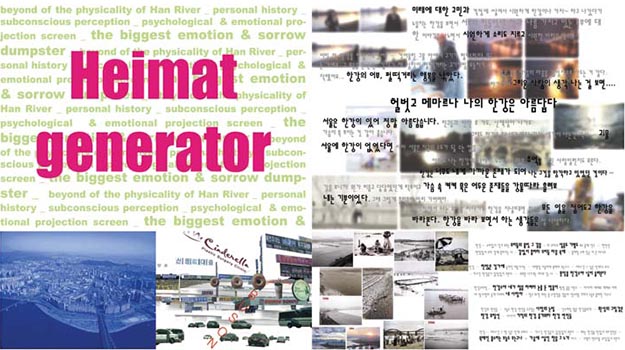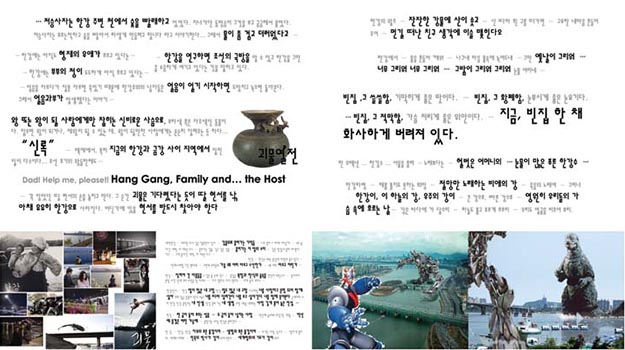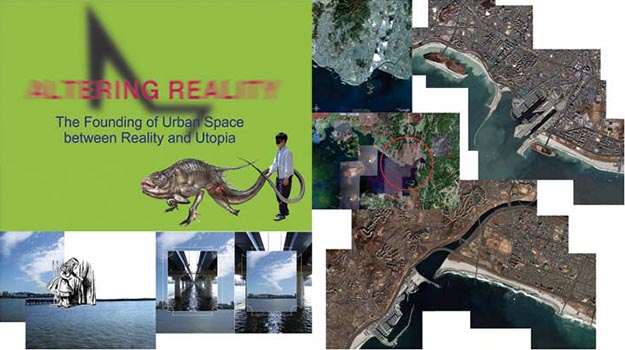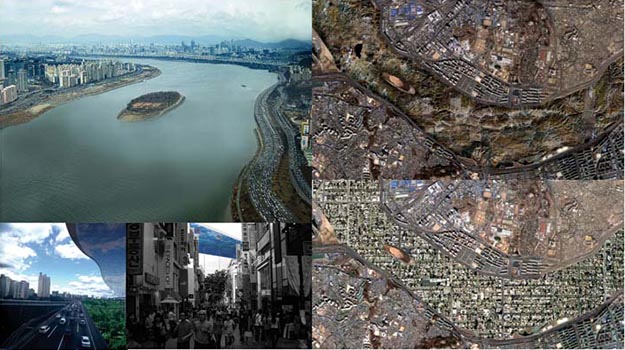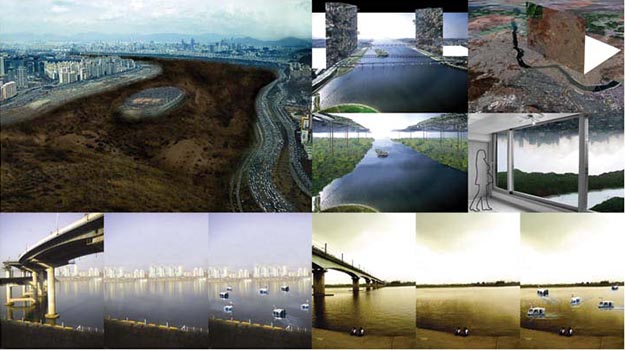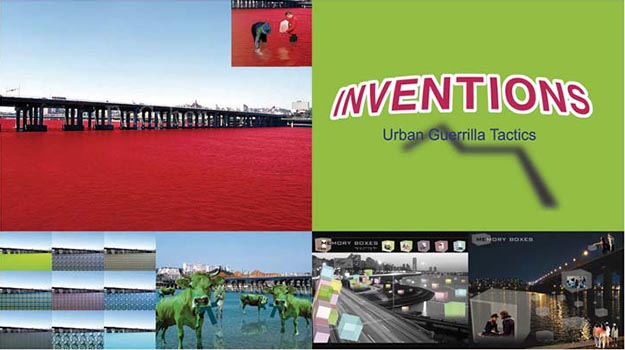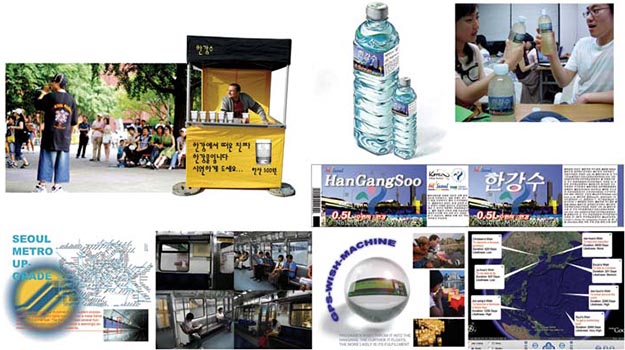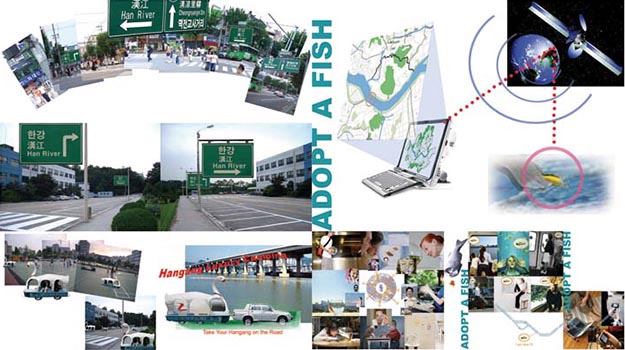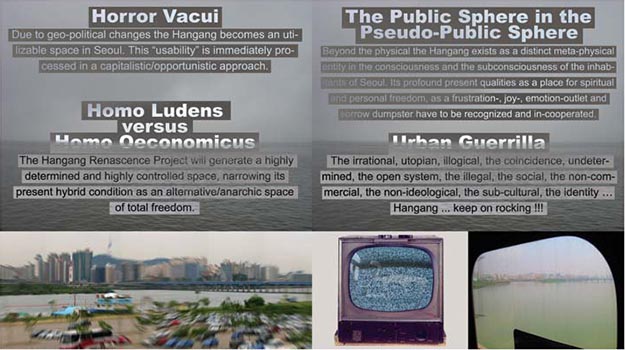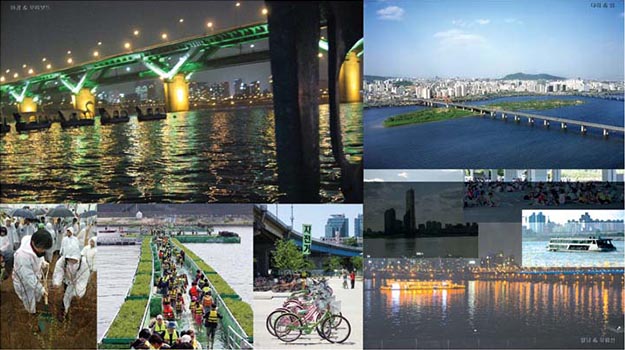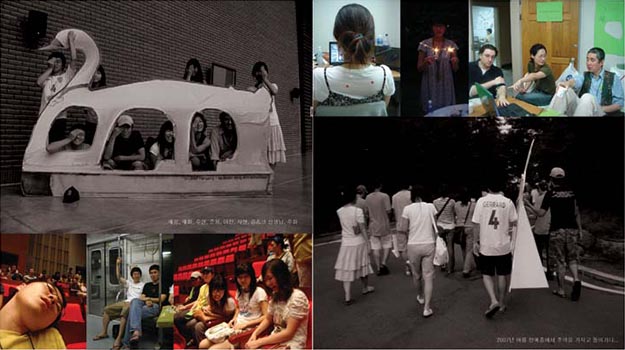|
foster's home for
imaginary friends
studio ryul song, christian schweitzer, sangsoo ahn
with jaewoong ko, suhyun kim, jeehyun kim, juhwa baek, jaehwa jung,
eogin chae, junyong choi
in sa 2007 summer workshop_hyper.polis III_old watercourses new
perspectives_seoul, sa school / sa seoul association of architects
workshop july 28 - aug. 03 2007, korea national university of
arts, seoul
exhibition aug. 18 - aug. 23
2007, former seoul central station, seoul
content: synopsis / studio work /
exhibition
Synopsis / Foster's Home for Imaginary Friends1)
by Christian Schweitzer
The population of Seoul is stacked in always higher mono-functional
apartment buildings. Historically grown urban fabrics are floored with
the lawnmower principle. Gated apartment complexes destroy any notion
of what is called 'urbanity.' A nomadic society emerges, moving from
one apartment to the other, upwards (quite literally) the social
ladder, breaking up traditional family patterns, communities, and
social structures. Meanwhile more than 54% of the population is living
in these urban non-places, and the number is steadily increasing. The
real-estate speculations have swollen up to a giant bubble bursting any
time. The population of Seoul is declining, freighted into satellite
cities stomped out of the ground in an irresponsible speed. The car is
still the number one priority in any urban redevelopment. At the same
time the general population is aging excessively, by 2020 the Korean
society will be an "aged population" with more than 14% elderly people.
80% (92% in Seoul) of the current population in their 20s is getting an
academic education, of which only 30% will find an equivalent job. The
unemployment rate is increasing steadily, so does the crime rate. The
income gap is drastically widening. 1,2 million women are engaged in
prostitution, which is about 5% of the female population. The air
pollution is getting worse and worse, the impact of the climate change
is starting to leave its marks.
Considering all these problems, why the hell are we dealing with the
Han River? According to a recent survey more than 30% of the
inhabitants of Seoul recognize the Han River as the first landmark and
subject of identification in Seoul, followed by the Cheongaechun River
and the Bukhan Mountain, far behind only in fourth place a manmade
structure, the Gyeoungbok Palace, is mentioned. Therefore Seoul in its
perception is the most 'Seoul', where it actually isn't at all; one of
the densest cities in the world, the mega city Seoul, identifies itself
with the most anti-urbane feature of all, the most radical of all
spaces, the void; a void as scale less, inconceivable and ephemeral as
Seoul itself. Dealing with the Han River is dealing with the essence of
Seoul, not looking at its problems but at its state of mind and
therefore at its potentials beyond its flaws.
This identification of Seoul with the Han River, with a natural
feature, raises interesting questions about the understanding of Seoul
as a "Heimat" to its inhabitants. The German word "Heimat" (maybe best
to translate with the metaphysical meaning of 'gohyang') refers to the
relationship between human being and space. Nevertheless the
geographical-historical containment of the reference areas is not a
fixed one, but movable depending on certain situations. "Heimat" could
describe a region, a landscape, but also a city, a country, a nation
and even a way of living or self-definition ("my home is poetry"). It
is the entirety of the circumstances in which one is living, in which
one is growing up; it forms his/her psychic. "Heimat" therefore does
not describe a specific location, but identity. This makes the Han
River a Heimat-generator, the essential creator of meaning. But if
"nature" is a key element of thinking, unlike in Europe where the point
of identification with a city always is a building, it raises at the
same time the question: why then does the rest of Seoul look like a
tuned trash bag?
And to make it even more confusing the Han River is probably the most
neglected, disconnected and non-functional space in Seoul. The common
thought would be to solve these superficial problems, but at the same
time risking by its profane-ization to destroy its significance for the
psychology of the inhabitants of Seoul. The embankments, highways and
walls of apartments are probably the reason for the idealization of the
Han River. Its physical disconnection triggers an "Alice in
Wonderland"-effect, through the rabbit hole, the harder to reach the
higher the reward, the more distant the larger it becomes (who does not
know this wonderful relieving one-minute moment crossing the Han River
by car or subway leaving the city far behind, which would instantly
disappear if we knew, we could actually stop here). Utilization means
banal-ization and disney-fication through profane and common function.
The Han River would become a prevention machine that reproduces the
illusion of reality. By simulating an ideal world along the river the
population of Seoul would be suggested to be at the Han River in the
real world, so they can transform the inadequacy and kitschyness of
their existence into an illusion.2)
By subducting
the distance-ing the
Han River would lose its most important role as the probably biggest
emotion and sorrow dumpster in Korea as it can be seen in every
TV-drama(fig 1). Only the
present inhospitality
guarantees the
catharsis. The potential of the Han River does not lie in its
physicality but in its immaterial presents as the last fixture for the
deracinated nomadic population of Seoul. As the opposite of the
'unknown', the 'strangeness' of Seoul, "Heimat" is also understood in
terms of the utopian as 'the yet to be established place beyond
alienation.'
In this studio we try to deal with the utilization of the intangible
function of the Han River as a psychological and emotional projection
screen. We will try to find out whether the Han River has a potential
beyond architectural function and program, whether the subconscious
perception of a 'landmark' can be utilized beyond its physical limits
as a conceptual tool to deal with the "phenomenon"of Seoul as a whole.
In a way we try to answer Jean Baudrillard's essential question to
architecture: "Is there a necessity, is there a possibility to
structure this space in a different way than by its endless horizontal
and vertical extension? In other words: is it possible in the light of
the radicality of space to reveal a truth of architecture?"3)
Workshop Preparation: Keywords for the task are: 'Heimat', Identity of
Seoul, image and perception of the Han River, architectural utilization
of an irrational feeling, psychology, sociology and art. The students
will be asked to collect and evaluate secondary 'literature' dealing
with the Han River like TV-dramas, movies, cartoons, pulp novels,
mythology, poems, song lyrics, postcards, commercials, advertisements,
image campaigns, documentaries, interviews, statistics, surveys,
memorabilia, diary and blog entries, amateur photos, trash and kitsch,
etc. etc., in order to create a mental map of the perception and
idealization of the Han River. The aim is to map the mental
transformation of the Han River from a physical location towards a
state of mind.
Main Workshop: In the beginning of the main workshop according to the
results of the pre-studies and research keywords are extracted that
reflect the 'philosophical' programs, functions, and values of the Han
River. These keywords will be tested on their ability to be applied on
Seoul as a whole, on the one hand as (re)activators of existing
conditions due to their potential as 'Heimat'-generators, on the other
hand as inventions to trigger this generating effect. Questions have to
be answered like "can we buy the Han River for our home", "can we bring
it to other parts of Seoul", "do we need it anyway at all," and "why is
Seoul not located at the sea" (or maybe it is and we just don't know
it).
References:
Life itself, "Being a burden is great. It's like my ...
seventh favorite thing to be." Blooregard "Bloo" Q. Kazoo
Notes:
1) Borrowed from the cartoon-show "Foster's Home for Imaginary Friends"
created by Craig McCracken in 2004, (c) by Cartoon Network.
Eight-year-old Mac has outgrown
his imaginary friend, says his mother,
so he takes his buddy Bloo (a walking, talking security blanket) to
Foster's Home for Imaginary Friends. Here all sorts of odd characters,
given up by their creators, are welcome to stay until new kids come to
adopt them.
2) Compare Jean Baudrillard in "Simulacres et Simulation" [Simulacra
and Simulation], Editions Galilee, Paris 1981.
3) Jean Baudrillard, "Architektur: Wahrheit oder Radikalitaet?"
[Architecture: Truth or Radicalism?], Reihe: Essays Nr. 40, Verlag
Droschel, Graz 1999, page 5.
|
|
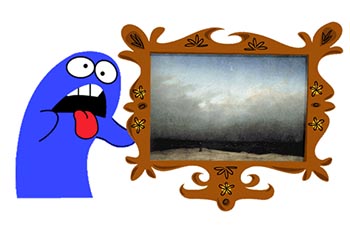
fig 1: Blooregard Q. Kazoo commenting
Casper-David Friedrich's "Monk by
the Sea"from 1809 at the Palace Charlottenburg in Berlin, June 2007.1)
|

